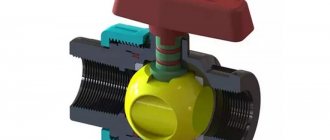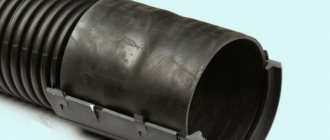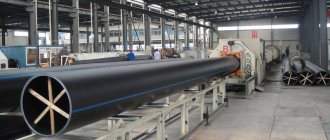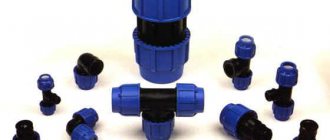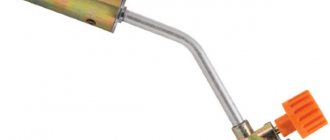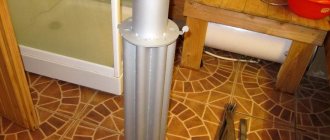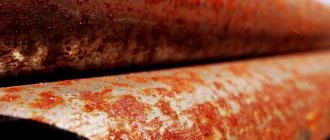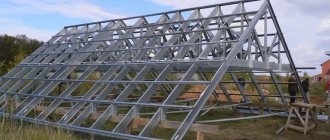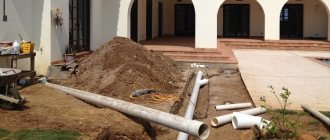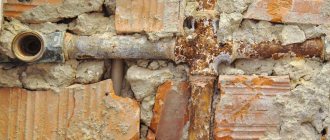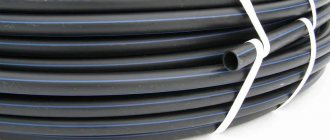Greetings to our regular reader!
A comfortable temperature regime at home and in the workplace allows you to maintain efficiency and health in hot summer conditions or keep warm in the early cool autumn. Modern air conditioners allow you to create the desired microclimate in a room, ventilate the room without opening windows, and clean and dry the air. But no air conditioner can be installed without laying pipelines between the outdoor and indoor units. Copper pipes for air conditioners are used for these pipelines - and in our article we will tell you about them.
Features of copper pipes for refrigeration and split systems.
In refrigeration and split systems, the refrigerant is freon. To create a freon circuit between the blocks, capillary copper pipes are used, in which the gas expands and cools. Typically these are round copper pipes made by cold deformation (“drawn”). The connection between the air conditioner units (internal and external) is made by tubes of different diameters. Thus, the tube through which the refrigerant flows from the indoor unit to the outdoor unit always has a larger diameter. In household air conditioners, tubes with a diameter of 1/4 and 3/8" are more often used, since they have different purposes. On one side, freon enters in the form of a gas, and on the other in the form of a liquid.
The most common consumable material for the installation of almost any refrigeration and climate systems is a copper tube for a split system with a cross-sectional diameter of 1/4" (6 mm), 1/2 (12 mm), 3/4 (19 mm), 5 /8 (16 mm), 3/16 (4.6 mm) and 5/16 (7.93 mm). The more powerful the air conditioner you choose, the larger the tube diameter will be required. It is not necessary to look for oxygen-free copper; it is enough that phosphorus impurities are present in the composition. This additive increases the metal's resistance to temperature changes.
The use of copper grade CU-DPH according to DIN 1412 will increase the corrosion resistance of pipes. Soft (annealed) copper is most often used in coils, but hard dimensional copper can also be used. Copper pipes for climate control systems are manufactured in accordance with TU 184450-106-181-2006.
When purchasing a tube, quality control is carried out by checking the presence of plugs at the ends of the tube, which prevent littering or dusting of the internal cavity.
To increase the efficiency of the system, as well as protect the circuits from condensation or overheating, thermal insulation is used for copper pipes, which must be carried out in all open areas except for connection points. Typically, pre-cut two-meter braids of foamed polymers are purchased. Thermal insulation covered with copper tubes is glued at the joints with acid-free silicone sealant or simply wrapped with electrical tape. Each tube must be insulated separately.
For refrigeration equipment, a brass tube can be used, which, under conditions of prolonged interaction with liquid and vaporous media, has better anti-corrosion resistance than copper. This is why the food industry prefers to use brass (with the addition of zinc and lead) for refrigeration systems.
The table shows the average cost of the smallest tube coil that can be used in split systems.
| Copper tube for air conditioners - split systems - refrigerators | ||
| Size | price for 1 meter | price per bay (15 meters) |
| 1/4 - 6 (mm) | 100 rub. | 1,100 rub. |
| 3/8 - 10 (mm) | 150 rub. | 1,700 rub. |
| 1/2 - 12 (mm) | 230 rub. | 2,900 rub. |
| 5/8 - 16 (mm) | 330 rub. | 4,200 rub. |
| 3/4 - 19 (mm) | 400 rub. | 5,300 rub. |
Advantages and disadvantages of copper pipes
Copper elements that are used to make heating systems have strengths and weaknesses. Advantages:
- Service life up to 50 years.
- Withstand pressure over 30 atmospheres.
- The material does not react to ultraviolet radiation and is resistant to corrosion under natural conditions.
- No air leaks through the walls.
- Copper does not emit harmful substances. Has antibacterial properties.
- Light weight.
- It is possible to defrost the system 3 times.
- The material can withstand prolonged exposure to active chemicals and does not release any additional elements.
- Deposits do not accumulate on the inner surface of the products.
- Low rate of thermal expansion, which does not require the installation of expansion joints.
Flaws:
- High price when compared with other materials.
- The connections are permanent, which may cause difficulties during installation.
- Galvanic corrosion can occur if you try to combine copper with other metals.
- If the room has a high level of humidity, corrosion may appear on the surface of the products.
- High electrical conductivity contributes to the deterioration of the walls of products.
- To reduce heat loss in the walls, it is necessary to use additional insulation.
Flux
Due to the specific chemical structure of aluminum, you may encounter difficulties during soldering. The reason is that aluminum is a fairly reactive metal.
This means that the reagents can be different chemicals. When this non-ferrous metal interacts with oxygen, the formation of a very thin and at the same time unusually strong oxide film is observed on the surface of the product. Due to the fact that the properties of aluminum and its oxide are completely opposite, the formation of this film should be completely eliminated. For this purpose you will need flux.
With the help of this auxiliary material, oxides are removed from the solder and the surface of the product being soldered. In addition, flux prevents their formation. Judging by the reviews, the best brand is F-64 with 40% active fluorine content. After work, the surface to be soldered must be washed. Flux A-214 is considered a universal no-clean agent with a melting point from 150 to 400 degrees. After work, its residues can be easily removed with a regular napkin, which is pre-moistened with alcohol.
Areas of application
There are several situations when it is better to choose this material:
- The current option for installing a heating system made of copper pipes is connecting to a solid fuel boiler. This is due to the fact that such systems are exposed to prolonged exposure to high temperatures (over 100 degrees Celsius).
- Compared to other materials, copper is better if it has a complex shape.
- Installation will be 100% justified if the owner of the house has enough money and wants to get the highest level of durability.
When considering other options, you need to pay attention to plastic or stainless steel
Features of laying and welding
Work on laying copper pipes in air conditioning systems is based on the following algorithm:
- route marking with determination of the location of blocks;
- wall gating or other additional work, if required;
- laying the route.
In most cases, the copper pipe for air conditioners is placed in a box
It is important that the location of the drainage channel for condensate removal is sloped. Insulation is performed when it is not present in the original product
Regardless of the type of line - liquid or gas - it must be tightened with plastic clamps.
When the laying is completed and the route is securely fixed, both blocks (internal, external) are mounted. Then they, together with the pipes, are connected into one system, and the joints are checked for leaks.
It should be noted that air conditioning copper tubes are simple and easy to install and operate. Annealed elements can be bent at various angles, and the possibility of tearing or deformation of the product is completely eliminated.
Varieties
Copper is resistant to caustic environments. Therefore, pipelines for moving freon are made from such metal. This is a hydrocarbon substance containing fluorine, belonging to the group of freons. It is the working medium in air conditioning systems.
To move refrigerant in liquid and gaseous states between the outdoor and indoor units, one of two types of copper pipes are used:
- Annealed with good flexibility, withstand high pressure without surface deformation. They are supplied in coils of 15, 25 or 50 m. Pipelines made from them have a strength of 210,000-220,000 kPa and an elongation at break of 50% to 60%.
- Unannealed, in the form of rods with a minimum length of 3 or 5 m. They are characterized by a strength of 280,000-300,000 kPa and an elongation at break of 10% to 15%.
The type of copper pipe is selected depending on the type of air conditioning system. When installing split systems, annealed ones are used.
Installation
The ends of copper pipes are closed at the factory with plastic plugs. This protects the internal space from a humid environment, debris, dust particles and other contaminants. It is better to buy only copper pipes with plastic plugs. The smallest debris inside can damage the climate control equipment.
Regulatory Requirements
Technical requirements for copper pipes are determined by GOST 617-2006.
Copper pipes are manufactured with diameters from 3 to 360 mm, wall thickness from 0.05 mm to 10 mm. For unannealed pipes, the working pressure ranges from 4 to 15 MPa (for diameters of 54 mm and 10 mm, respectively). For annealed pipes - from 6 to 11.5 mm (for diameters 54 mm and 3.1 mm). The permissible operating pressure decreases with increasing diameter.
For the production of pipes, refined M1 copper is used; M1f; M1p; M2; M3; M3p; Cu-DHP, Cu-DLP, Cu-FRTP.
The table shows the maximum operating pressure of copper pipes depending on the diameter and wall thickness:
| View | Diameter, mm | Wall thickness, mm | Maximum working pressure, MPa |
| Annealed | 10 | 1,0 | 10,46 |
| 12 | 1,0 | 8,71 | |
| 15 | 1,0 | 6,97 | |
| 18 | 1,0 | 5,81 | |
| 22 | 1,0 | 4,75 | |
| Unannealed | 10 | 1,0 | 15,05 |
| 12 | 1,0 | 12,54 | |
| 15 | 1,0 | 10,03 | |
| 18 | 1,0 | 8,36 | |
| 22 | 1,0 | 6,84 | |
| 28 | 1,0 | 5,37 | |
| 35 | 1,5 | 6,45 | |
| 42 | 1,5 | 5,37 | |
| 54 | 1,5 | 4,18 |
Production
Copper is a very ductile material, and copper pipes are made without welding.
Industrial methods for the production of seamless pipes: drawing, rolling, pressing, combined methods. Very rarely, thick-walled products are produced by welding. In practice, rolling and drawing are most often used.
Large-sized products are produced in several stages with intermediate heat treatment. After manufacturing, the pipes are necessarily annealed (heated, held for a certain time and cooled together with the furnace). After annealing, the structural stresses that appeared as a result of manufacturing disappear in the metal.
The use of copper pipes for air conditioning systems
Copper pipe for air conditioners is an important element when installing an air conditioning system of any level of complexity. As a rule, two copper pipes of different diameters are used: one of them is used to transport freon in a liquid state, and the other in a gaseous state.
Copper pipes for air conditioners
Copper is a ductile material that is resistant to corrosion and is excellent for transporting freon. Soldering and flaring of copper is quite easy, which further simplifies the installation and connection of various elements in the air conditioning system.
Advantages of installing air conditioners with copper pipes
Copper pipes are ideal for air conditioning and refrigeration systems. Their main advantages include:
- Good thermal conductivity;
- Smooth surface inside and outside;
- Corrosion resistance;
- Resistance to abrasion by sediment;
- Resistance to temperature changes;
- Tightness;
- Affordable price.
During the installation of air conditioners, seamless copper pipes are used, which are connected to each other using special fittings. As a rule, when sold, an air conditioner is supplied as a set consisting of indoor and outdoor units, and everything else is purchased separately during the installation process. It is between the two blocks that copper tubes are placed that transport the refrigerant through the system. The dimensions of copper pipes are directly related to the performance of the device.
Copper pipes for air conditioning systems
The larger the diameter of the tubes, the greater the performance of the air conditioner.
Air conditioner installation using copper components
Installing an air conditioner in modern homes is as follows:
- Choosing the location of the outer and inner sides.
- Drilling a hole in the wall with a diameter of 40 mm for laying pipes and cables.
- Installation of fastening of indoor and outdoor units.
- Laying of copper pipes, as well as their insulation.
Insulation increases the efficiency of the air conditioner and prevents moisture from accumulating inside the tubes.
- Cutting copper tubes with a pipe cutter and then flaring the free ends. Copper pipes can only be cut with a special pipe cutter, since a regular hacksaw or grinder can cause small particles to get inside the pipe and circulate through the system. Such particles are especially dangerous for capillary tubes with a diameter of 0.4-0.8 mm.
- Cleaning cut edges.
- Flaring of pipe ends to connect them to the indoor unit.
Flaring the ends of copper pipesFlaring plays an important role in the reliability of the air conditioner. Correctly performed flaring protects the system from freon leaks.
- As a result of flaring, tubes with attached nuts are obtained.
- Connection of tubes to the indoor unit.
- Exit the pipe to the outside and connect to the external unit.
- Laying a condensate drain pipe.
- Cable reinforcement with special tape.
- Vacuuming the system with a special vacuum pump.
- Disabling the vacuum pump and connecting the air conditioner to the network.
- Checking all units and systems for proper operation.
Insulation of pipes in air conditioning systems
Pipe insulation prevents heat loss during air conditioner operation. Rubber insulation has the best efficiency, which, due to its high thermal conductivity, contributes to the reliable operation of the device. Insulation also helps reduce the load on the compressor.
Copper pipe insulation
Rubber insulation requires additional wrapping with nylon tape, which protects the wire from exposure to the sun, as well as from mechanical shock. This tape plays an important role and if it is missing, unpleasant consequences may occur: the insulation may collapse and the compressor may fail.
Soldering elements for connection
In order to connect two pipe elements together, soldering with copper-phosphorus solder is used.
It is very important that the surface is absolutely clean, free of dirt, oil, paint and other contaminants.
The main requirement for a solder joint for refrigerants is tightness.
The soldering process occurs in stages:
One pipe is inserted into another, going deeper than half the diameter of the smaller one. The connection is heated evenly with a torch
It is very important to correctly calculate the heating temperature so that the metal does not begin to melt and enter into chemical reactions with the solder. The heating temperature is considered sufficient if the brazing rod melts upon contact with the tubes.
Properties and characteristics of copper tubes for air conditioners
To organize circulation between the blocks of the split system, it is necessary to use a material with high corrosion resistance. Copper meets this technical requirement perfectly.
After all, the circulation in the air conditioner is organized in such a way that both refrigerant and oil pass through the tubes. These substances are not chemically neutral. Also, copper tubes interact with water, which contains chlorine. In this case, despite the fact that chlorine acts as a powerful oxidizing agent, as a result of the reaction a protective layer appears on the copper tube.
It forms on the inner surface of copper tubes immediately after the air conditioner starts operating. A durable layer of oxides up to a few tenths of a millimeter thick does not allow limescale to settle on the surface of the tube, prevents the occurrence of corrosion processes, and protects the metal from destruction.
Copper tubes work well in the freeze-thaw mode. Their performance qualities do not change. Hard copper pipes withstand the 2nd cycle without changes, and semi-hard and soft pipes withstand the 3rd cycle of freezing and defrosting.
The above advantages make it advisable to use copper pipes for drinking water mains.
The strength of a copper tube, which is used in the production of air conditioners, varies between 280-300 MPa. Temperature range of use: -200ºC – +300 ºC. The value of the elongation coefficient at break varies from 12% to 15%.
The thermal expansion index of copper is low (0.0168 mm/m²C). It is 6-8 times less than the same figure for plastic.
In addition, copper tubes are highly resistant to hydrodynamic shocks and internal pressure. They are durable.
These tubes are not subject to corrosion. They can be easily installed in a cold or hot state, either manually or using a special tool.
The need for the use of this material is growing in proportion to the use of new alternative energy sources. They are used for the manufacture of collectors powered by solar energy, for the construction of heating mains and related communications.
Compared to plastic and aluminum-plastic, copper pipes have the following advantages:
1. Pipes made from environmentally friendly material - copper, can be used in drinking water systems.
2. Copper has the ability to destroy harmful bacteria in drinking water.
3. Copper can be used in the recycling process (waste processing) the required number of times without changing its properties.
4. The properties of the metal do not change with changes in temperature and pressure.
5. This is a material with high anti-corrosion properties. It is little exposed to oxygen, ultraviolet radiation and other aggressive environments.
To produce high-quality copper tubes for air conditioners, alloys with a minimum percentage of impurities are used. The percentage of copper in the alloy is 99.9%.
Based on physical characteristics, two types of tubes are distinguished: soft (annealed) and hard (unannealed).
The first ones are more flexible. The product can be bent at an angle of 90º. The second ones do not bend. For their installation, connecting elements - fittings, represented by angles, tees, and couplings - are used.
The production of copper tubes for split-system air conditioners is carried out according to TU 184450-106-181-2006. The chemical composition of the metal used for this production meets international quality standards.
Installation of copper pipes for air conditioners
Installation of pipelines between the external and external units of the air conditioner is completely doable with your own hands. If you purchased annealed pipes of the required length, then installation is carried out without welding.
Required tools and materials
To install copper pipes you will need:
pipe cutter for copper pipes or hacksaw;
flaring;
- file, sandpaper;
- FUM tape;
- spanners and gas wrench;
- rags.
- A pipe bender will come in handy - it will allow you to carefully bend pipes without wrinkles or deformations.
Precautionary measures
Be sure to wear safety glasses when cutting and stripping copper products.
Before filling the air conditioner with freon, be sure to check the operation of the system filled with air. Coat the joints with soap foam, turn on the air conditioner and let it run for a few minutes - the leak will be visible.
Work progress
The work is carried out after installing the air conditioner. First, carefully measure the distance from the external to the internal unit. The pipe is cut to a large margin in length. Thermally insulated products are cleaned of insulation at the ends. Insulation is put on uninsulated pipes.
Then carefully clean the ends of the pipes from burrs. Place union nuts with threads so that the threads are flush with the end of the workpiece. They are flared using a special device - flaring. This work must be done carefully - it is impossible for cracks, waves and folds to form on the tubes. The result is a reliable sealed connection between the nut and the tube.
Secure the pipeline to the fitting of the outdoor unit using a nut. Do not clamp the connection too hard - you can damage the tube.
Then the pipelines are placed inside the room and hung on brackets. Tubes for air conditioners are flexible, they can be bent if necessary simply by hand. With the help of a pipe bender, turns will be more accurate.
Then it is necessary to repeat all operations (cutting, deburring, flaring) and secure the pipeline to the indoor unit.
Installation features
The tubes must be insulated - for this there are all kinds of ready-made covers made of foamed polyurethane or polyethylene, sometimes coated with a layer of foil. Condensation will settle on an uninsulated pipe and drip onto the furniture. If the length of the communication is more than half a meter, then it is necessary to install special fastenings.
Work progress
Judging by numerous consumer reviews, anyone can do this job, even with little soldering experience.
To get started, purchase a pipe cutter, a special bending machine and welding equipment. Some home craftsmen use a hacksaw instead of a pipe cutter. According to experts, this should not be done, since the quality of work will not be the same. A pipe bender can be universal (it works with different diameters) and specific (designed for pipes of a certain diameter). Next, you should buy aluminum tubes, cut them to the required length and bend them on a bending machine. After preparing the pipes, start cutting the fittings and connect everything into one system. Before connecting, clean the tubes thoroughly using sandpaper or a wire brush. If grease, paint or soil remains on the products, the adhesion of the metal to the solder will be worse. If you want to connect two tubes, insert them into each other so that there is a small gap (0.2 cm), which will later be filled with molten solder. After completing these steps, you can proceed directly to the soldering itself.
Technical characteristics, diameter and dimensions of pipes
Copper pipes for air conditioning are selected according to their cross-section. The speed of refrigerant circulation depends on their diameter. In addition, with a correctly selected cross-section, the likelihood of a pressure drop in the climate control equipment units is eliminated.
Copper tubes can have a diameter ranging from 6-26.7 mm. This gap fits 26 standard sizes. The following pipes are suitable for use in air conditioning systems: 19.05 mm, 6.35 mm, 12.7, as well as 15.88 and 9.52 mm. Typically, the section is indicated in inches, which is respectively equal to ½, ¼, ¾, 5/8 and 3/8 inches. The optimal pipeline wall thickness is 0.7 mm, but in principle this parameter can be in the range of 0.5-3 mm. Pipelines are sold in sections of 2 meters or in coils of 50, 25 or 15 meters.
The exact cross-section and length of the pipeline depends on the design features of the air conditioner, the presence of fittings and pipes of a certain diameter, as well as the nuances of the location of the external and internal units. Typically, tubes with a cross section of 6-16 mm are used.
Copper pipe insulation
Insulated copper lines are available for sale. The protective layer will prevent the circulating refrigerant from overheating or freezing under certain operating conditions.
The protective layer is made of foam rubber or a special type of polyethylene. This is a hollow tube about two meters long. The material can be used in the temperature range -150°С…+150°С. Since the thermal conductivity of copper is 0.394 kW/mK, and the same parameter of the insulating coating is only 36 mW/mK, the protective layer helps maintain the temperature of the coolant.
Thanks to the use of isolated freon lines, refrigerant consumption is significantly reduced, and this entails a reduction in electricity consumption. Thin copper walls of pipelines cannot prevent heat loss as well as insulation.
Advantages and disadvantages of copper pipes for air conditioners
Freon lines made of copper have many positive qualities:
- Corrosion resistance and increased strength are the main advantages of the material.
- Transportation and installation of the pipeline is simple and quick due to the low weight of the element.
- The ductility and flexibility of annealed pipes are an undeniable advantage.
- The antibacterial characteristics of the metal are also of no small importance.
- The smooth inner surface of the line reliably protects against blockages.
- The material easily tolerates temperature changes and its extreme values, increased pressure and vibration effects.
- Copper is resistant to ultraviolet rays and does not change its technical characteristics.
- Pipes are easy to cut, maintaining the original clearance of the line.
Since cutting a copper tube using the traditional method produces chips that can get into the pipeline and damage the HVAC equipment, do not use conventional cutting tools. Soldering or fittings are used to connect individual elements.
Due to the low melting point of solder, a conventional gas torch is used when connecting copper pipelines. To eliminate the possibility of freon leakage, it is better to choose the capillary method in high temperature conditions.
Kinds
There are two types of copper pipes - annealed and unannealed. Annealed ones are more ductile, flexible and less durable. Often supplied in coils. Unannealed ones are stronger and less ductile. They are usually supplied in whips.
There are products of round, rectangular and square cross-section. The last two species are practically never found.
In climate control technology, products with diameters of 19.05 are usually used; 6.35; 12.7; 9.52 and 15.88 millimeters (i.e. ¾, ¼, ½, 3/8 and 5/8 inches). The wall thickness is usually 0.7-0.8 mm.
Recently, a new product has appeared on sale - copper products with a heat-insulating layer of rubber, foamed polyethylene, thermoflex.
There are products with external and internal anti-corrosion coating, ribbed (with an outer layer of steel or aluminum).
Material characteristics
Copper is a very ductile and at the same time durable metal. Due to their high ductility, copper pipes can withstand impacts and bends even at subzero temperatures. Copper does not corrode and is chemically inert. The strength of copper is lower than that of steel, but higher than that of plastic. Copper tubes can have very thin walls. Copper has high thermal and electrical conductivity.
In many cases, plastic and plastic piping systems can be replaced with copper, but the widespread adoption of copper is hampered by its price and somewhat more complex installation compared to plastic systems.
Copper tubes are very widespread in the manufacture of refrigeration equipment, household appliances, appliances, household heating systems, and automobiles. Air conditioners are traditionally installed with copper pipes - more compact, reliable pipelines have not yet been invented.
Price difference
The cost of copper is constantly growing and depends on the exchange rate. The decrease in the quantity and quality of the mined metal, its increasing shortage, contribute to the constant rise in prices for copper products. Therefore, the issue of finding an alternative that can replace copper in the production of air conditioning systems is one of the most pressing.
Aluminum has only recently begun to be used in cryogenic equipment (refrigerators, car air conditioners). The cost is stable and almost three times cheaper than copper; there are large reserves in nature. This opens up great prospects for the industrial production of products from this metal.
Advantages of copper products
Due to their performance properties, copper pipes are widely used for transporting various liquids. Among the advantages of such products are:
- Plasticity and strength. Copper products have high strength and ductility. At low temperatures, these properties increase significantly. This makes it possible to use a copper pipeline for transporting non-freezing liquids.
- Resistant to sudden temperature changes. Copper pipes do not lose their performance properties at extreme temperatures. This also applies to high blood pressure. Such pipes can withstand a load of 400 atmospheres.
- Slight thermal expansion.
- The versatility of the material. For the construction of one or another utility line, you can use pipes with a small wall thickness. So, for example, if we take steel or plastic analogues, then to solve a similar problem we needed products whose wall thickness was several times greater.
- Resistant to chlorine and other chemicals that may be contained in the transport fluid. Upon contact with copper, an oxide is formed, which extends the life of the product.
- Copper pipes are not afraid of ultraviolet rays, chemically aggressive substances and corrosion. Thanks to these properties, the service life of the pipeline can reach 100 years or more.
- Copper inhibits the development of bacteria, which makes the pipeline safe.
- The inner walls of copper products have a smooth surface. Thanks to this, pipes with a small diameter can be used to construct the pipeline. At the same time, throughput is at a high level.
- Dismantled copper pipes can be reused to construct a new heating or water supply system pipeline.
- Copper pipes have an attractive appearance. This makes it possible to abandon the installation of decorative boxes. The products themselves can be used as a decorative element.
Due to the presence of such advantages, copper pipes are especially popular among professionals and are used in various fields.
Installation features
To install a split system yourself, a few linear meters of copper pipes are enough.
At the preparatory stage, it is necessary to determine the length of the pipe by measuring the distance between the internal and external blocks, taking into account the bends and thickness of the load-bearing wall. To the resulting length you need to add another 0.5-1 linear meter of pipe to avoid problems during connection.
When connecting indoor and outdoor units, two methods of connecting pipes are used - soldering and using fittings. Using solder and a gas torch is considered the preferred option because... allows you to achieve perfect tightness.
Algorithm for installing copper pipes:
- Having decided on the size of the pipe, the master cuts it using a pipe cutter and cleans it.
- At the places where the pipes are connected to the air conditioner units, the standard nuts are unscrewed.
- The removed nuts are put on the prepared pipes.
- The edges of the pipes are flared using a special tool.
- An insulating sleeve is placed on the pipes prepared for installation.
- The pipes are pre-bent in accordance with the shape and geometry of the holes and grooves in the wall where the split system units are already installed.
You can bend a copper pipe either manually or using a special tool. For large diameter copper pipes, it is advisable to use a pipe bender
But if it is not there, you can use the classic technique: fill the pipe with sand, heat it to the desired temperature and carefully bend it by hand
After bending, it is important to carefully remove all sand
The pipe is installed in the standard holes of the air conditioner units, after which they are tightened with nuts using a special wrench or ratchet.
When connecting copper pipes to the air conditioner, you should not use silicone or rubber seals, because copper itself creates the required level of insulation. But just in case, after completing the work, you need to do a test run of the air conditioner and check the tightness of the pipes using a leak detector.
Results
Installing an air conditioner is not as simple a task as it might seem at first glance. Installation is time-consuming and requires the installer not only to have tools, but also certain knowledge. However, even before installation, it is important to choose the right components so that all the work does not go down the drain.
Today we shared our opinion about copper pipes. About their advantages and disadvantages, features of selection and installation. There are always disputes between installers and home craftsmen about components. In this article, we told you which copper pipes fall under our quality criteria and how to install them correctly.
Still have questions? Ask them in the comments below. Also read other articles on our website and share them on your social networks. Good luck!
Adviсe
Let's look at how to properly cut copper pipes. Accuracy and accuracy are very important here. To do this, as mentioned above, you will need a pipe cutter: at the very end you need to install a pipe and slowly begin to rotate it in the opposite direction from the stroke
As a result, the cutting angle should not be more or less than 90 degrees. If soldering is used for pipe installation, it is very important to observe the temperature conditions during soldering and ensure sufficient ventilation of the room, since cadmium vapors and fluoride compounds released during heating can be hazardous to health! When using the option of connecting copper pipes with fittings, the most important thing is to thoroughly clean their edges from burrs. When tightening the nut during installation with compression fittings, it will be enough to stretch it 1-2 turns from the initial stop. To prevent the pipeline from freezing or overheating (in other words, to create insulation), it is sometimes placed in a special sleeve made of polyethylene or foam rubber. This also improves the energy efficiency of the structure.
To learn how to install an air conditioner, watch the video below.
Insulation
Effective operation of the air conditioning system is possible if the freon transported through copper tubes does not overheat and does not freeze. Therefore, special insulating material is used. It reduces the risk of formation of critical volumes of condensate.
Insulated copper pipe for air conditioners.
Insulation for copper routes of air conditioning systems is a tubular element 2 m long. Foamed rubber with a non-porous structure or special polyethylene is used for its manufacture. The insulation protects freon pipes at temperatures from -150°C to +150°C.
The relevance of using the material becomes clear when comparing its thermal conductivity with the same characteristic of copper. For insulation and metal, this figure is 36 mW/(m*K) and 394 W/(m*K).
The use of copper pipes in insulation for air conditioners reduces the consumption of refrigerant. Therefore, electrical energy consumption is reduced.

